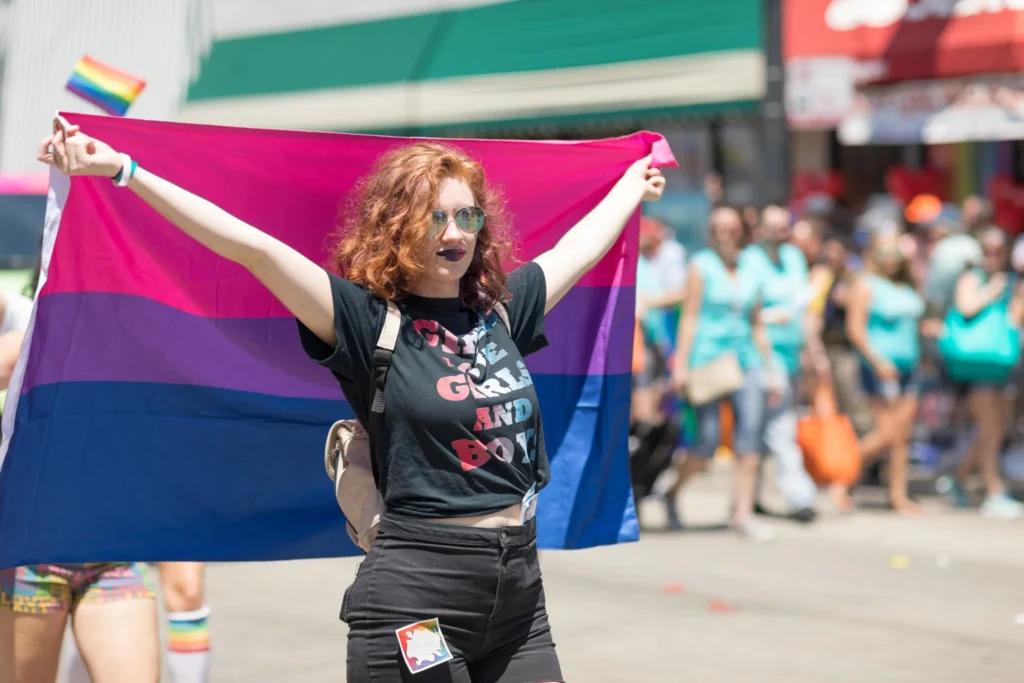In the vibrant tapestry of LGBTQ+ pride flags, the Bisexual Flag stands as a symbol of visibility, identity, and inclusivity. Designed to represent bisexuality, individuals, and the broader bisexual community, the flag is adorned with three distinct stripes, each carrying profound symbolism. As we delve into the history, significance, and interpretation of the bisexual pride flag, we uncover layers of meaning that resonate deeply with the experiences and identities of bisexual people worldwide.
Origins and Evolution
The origins of the Bisexual Flag can be traced back to 1998 when Michael Page, an activist and designer from the United States, first proposed the concept. Page sought to create a symbol specifically for the bisexual community, one that would resonate with its unique experiences and challenges. Collaborating with colleagues, Page conceptualized a flag composed of three horizontal stripes: pink, blue, and purple.
The colors were chosen with deliberate intent, each representing a facet of bisexuality. The pink stripe symbolizes attraction to the same gender, while the blue stripe represents attraction to the opposite gender. The intersection of these two colors creates a vibrant purple stripe, signifying attraction to all genders, including non-binary individuals and those with diverse gender identities.
Symbolism and Interpretation
At the heart of the Bisexual Flag lies its rich symbolism, inviting diverse interpretations and reflections on the complexity of bisexuality. The pink stripe, often interpreted as representing attraction to the same gender, serves as a nod to the presence of homosexuality within bisexuality. It acknowledges and affirms the experiences of individuals who are attracted to people of the same gender, regardless of their own gender identity. Conversely, the blue stripe symbolizes attraction to the opposite gender, acknowledging the presence of heterosexuality within bisexuality. This recognition of attraction to both men and women reflects the fluidity and diversity inherent in bisexual identity.
The purple stripe, perhaps the most distinctive feature of the bisexual pride flag, represents the overlap of pink and blue, symbolizing attraction to all genders. This inclusivity extends beyond the binary framework of gender, encompassing non-binary individuals, transgender individuals, and those with diverse gender identities. It serves as a powerful affirmation of the diverse and multifaceted nature of human attraction.
Visibility and Representation
Beyond its symbolism, the Bisexual Flag plays a crucial role in fostering visibility and representation for bisexual individuals within the broader LGBTQ+ community. Historically, bisexuality has often been marginalized or misunderstood, overshadowed by the binary narratives of homosexuality and heterosexuality. The creation of the Bisexual Flag marked a significant step towards addressing this erasure, providing a tangible symbol of identity and belonging for bisexual people worldwide.
Through its vibrant colors and distinctive design, the Bisexual Flag serves as a beacon of visibility, signaling the presence and significance of bisexuality within LGBTQ+ spaces. It provides a sense of solidarity and community for bisexual individuals, affirming their identities and experiences in a world that often overlooks or dismisses them.
Challenges and Empowerment
Despite its growing visibility and acceptance, the bisexual community continues to face unique challenges and obstacles. Bisexual individuals often confront stigma and discrimination from both heterosexual and homosexual communities, grappling with stereotypes and misconceptions about their sexuality. The Bisexual Flag serves as a rallying point for advocacy and empowerment, challenging misconceptions and celebrating the diversity of bisexual experiences.
By proudly displaying the bisexual pride flag, individuals and organizations signal their support for bisexual rights and visibility, fostering a more inclusive and affirming environment for all members of the LGBTQ+ community. From pride parades to social media campaigns, the flag serves as a powerful tool for advocacy and activism, promoting understanding and acceptance of bisexual identities.
Conclusion
In the colorful mosaic of LGBTQ+ pride flags, the Bisexual Flag shines as a symbol of visibility, identity, and inclusivity. Designed with deliberate intent, its vibrant hues and layered symbolism reflect the complexity and diversity of bisexuality. From its origins in the late 1990s to its widespread adoption today, the Bisexual Flag has become an enduring symbol of empowerment and solidarity for bisexual individuals worldwide.
As we celebrate and honor the significance of the bisexual pride flag, let us reaffirm our commitment to inclusivity and acceptance within the LGBTQ+ community. By embracing the diversity of human experience and identity, we can create a world where all individuals are valued, respected, and celebrated for who they are.







